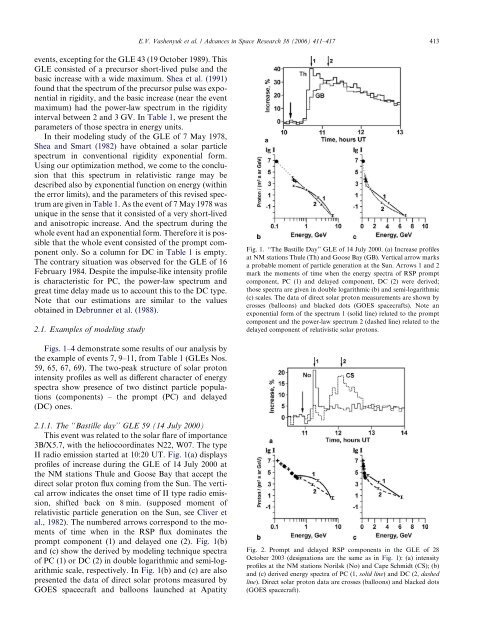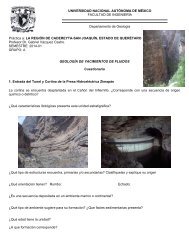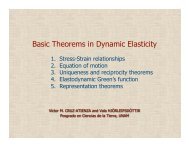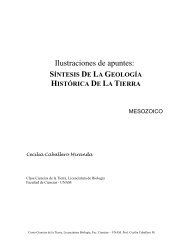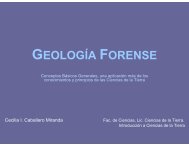Some features of the sources of relativistic particles at the Sun in the ...
Some features of the sources of relativistic particles at the Sun in the ...
Some features of the sources of relativistic particles at the Sun in the ...
- No tags were found...
Create successful ePaper yourself
Turn your PDF publications into a flip-book with our unique Google optimized e-Paper software.
E.V. Vashenyuk et al. / Advances <strong>in</strong> Space Research 38 (2006) 411–417 413events, except<strong>in</strong>g for <strong>the</strong> GLE 43 (19 October 1989). ThisGLE consisted <strong>of</strong> a precursor short-lived pulse and <strong>the</strong>basic <strong>in</strong>crease with a wide maximum. Shea et al. (1991)found th<strong>at</strong> <strong>the</strong> spectrum <strong>of</strong> <strong>the</strong> precursor pulse was exponential<strong>in</strong> rigidity, and <strong>the</strong> basic <strong>in</strong>crease (near <strong>the</strong> eventmaximum) had <strong>the</strong> power-law spectrum <strong>in</strong> <strong>the</strong> rigidity<strong>in</strong>terval between 2 and 3 GV. In Table 1, we present <strong>the</strong>parameters <strong>of</strong> those spectra <strong>in</strong> energy units.In <strong>the</strong>ir model<strong>in</strong>g study <strong>of</strong> <strong>the</strong> GLE <strong>of</strong> 7 May 1978,Shea and Smart (1982) have obta<strong>in</strong>ed a solar <strong>particles</strong>pectrum <strong>in</strong> conventional rigidity exponential form.Us<strong>in</strong>g our optimiz<strong>at</strong>ion method, we come to <strong>the</strong> conclusionth<strong>at</strong> this spectrum <strong>in</strong> <strong>rel<strong>at</strong>ivistic</strong> range may bedescribed also by exponential function on energy (with<strong>in</strong><strong>the</strong> error limits), and <strong>the</strong> parameters <strong>of</strong> this revised spectrumare given <strong>in</strong> Table 1. As <strong>the</strong> event <strong>of</strong> 7 May 1978 wasunique <strong>in</strong> <strong>the</strong> sense th<strong>at</strong> it consisted <strong>of</strong> a very short-livedand anisotropic <strong>in</strong>crease. And <strong>the</strong> spectrum dur<strong>in</strong>g <strong>the</strong>whole event had an exponential form. Therefore it is possibleth<strong>at</strong> <strong>the</strong> whole event consisted <strong>of</strong> <strong>the</strong> prompt componentonly. So a column for DC <strong>in</strong> Table 1 is empty.The contrary situ<strong>at</strong>ion was observed for <strong>the</strong> GLE <strong>of</strong> 16February 1984. Despite <strong>the</strong> impulse-like <strong>in</strong>tensity pr<strong>of</strong>ileis characteristic for PC, <strong>the</strong> power-law spectrum andgre<strong>at</strong> time delay made us to account this to <strong>the</strong> DC type.Note th<strong>at</strong> our estim<strong>at</strong>ions are similar to <strong>the</strong> valuesobta<strong>in</strong>ed <strong>in</strong> Debrunner et al. (1988).2.1. Examples <strong>of</strong> model<strong>in</strong>g studyFig. 1. ‘‘The Bastille Day’’ GLE <strong>of</strong> 14 July 2000. (a) Increase pr<strong>of</strong>iles<strong>at</strong> NM st<strong>at</strong>ions Thule (Th) and Goose Bay (GB). Vertical arrow marksa probable moment <strong>of</strong> particle gener<strong>at</strong>ion <strong>at</strong> <strong>the</strong> <strong>Sun</strong>. Arrows 1 and 2mark <strong>the</strong> moments <strong>of</strong> time when <strong>the</strong> energy spectra <strong>of</strong> RSP promptcomponent, PC (1) and delayed component, DC (2) were derived;those spectra are given <strong>in</strong> double logarithmic (b) and semi-logarithmic(c) scales. The d<strong>at</strong>a <strong>of</strong> direct solar proton measurements are shown bycrosses (balloons) and blacked dots (GOES spacecrafts). Note anexponential form <strong>of</strong> <strong>the</strong> spectrum 1 (solid l<strong>in</strong>e) rel<strong>at</strong>ed to <strong>the</strong> promptcomponent and <strong>the</strong> power-law spectrum 2 (dashed l<strong>in</strong>e) rel<strong>at</strong>ed to <strong>the</strong>delayed component <strong>of</strong> <strong>rel<strong>at</strong>ivistic</strong> solar protons.Figs. 1–4 demonstr<strong>at</strong>e some results <strong>of</strong> our analysis by<strong>the</strong> example <strong>of</strong> events 7, 9–11, from Table 1 (GLEs Nos.59, 65, 67, 69). The two-peak structure <strong>of</strong> solar proton<strong>in</strong>tensity pr<strong>of</strong>iles as well as different character <strong>of</strong> energyspectra show presence <strong>of</strong> two dist<strong>in</strong>ct particle popul<strong>at</strong>ions(components) – <strong>the</strong> prompt (PC) and delayed(DC) ones.2.1.1. The ‘‘Bastille day’’ GLE 59 (14 July 2000)This event was rel<strong>at</strong>ed to <strong>the</strong> solar flare <strong>of</strong> importance3B/X5.7, with <strong>the</strong> heliocoord<strong>in</strong><strong>at</strong>es N22, W07. The typeII radio emission started <strong>at</strong> 10:20 UT. Fig. 1(a) displayspr<strong>of</strong>iles <strong>of</strong> <strong>in</strong>crease dur<strong>in</strong>g <strong>the</strong> GLE <strong>of</strong> 14 July 2000 <strong>at</strong><strong>the</strong> NM st<strong>at</strong>ions Thule and Goose Bay th<strong>at</strong> accept <strong>the</strong>direct solar proton flux com<strong>in</strong>g from <strong>the</strong> <strong>Sun</strong>. The verticalarrow <strong>in</strong>dic<strong>at</strong>es <strong>the</strong> onset time <strong>of</strong> II type radio emission,shifted back on 8 m<strong>in</strong>. (supposed moment <strong>of</strong><strong>rel<strong>at</strong>ivistic</strong> particle gener<strong>at</strong>ion on <strong>the</strong> <strong>Sun</strong>, see Cliver etal., 1982). The numbered arrows correspond to <strong>the</strong> moments<strong>of</strong> time when <strong>in</strong> <strong>the</strong> RSP flux dom<strong>in</strong><strong>at</strong>es <strong>the</strong>prompt component (1) and delayed one (2). Fig. 1(b)and (c) show <strong>the</strong> derived by model<strong>in</strong>g technique spectra<strong>of</strong> PC (1) or DC (2) <strong>in</strong> double logarithmic and semi-logarithmicscale, respectively. In Fig. 1(b) and (c) are alsopresented <strong>the</strong> d<strong>at</strong>a <strong>of</strong> direct solar protons measured byGOES spacecraft and balloons launched <strong>at</strong> Ap<strong>at</strong>ityFig. 2. Prompt and delayed RSP components <strong>in</strong> <strong>the</strong> GLE <strong>of</strong> 28October 2003 (design<strong>at</strong>ions are <strong>the</strong> same as <strong>in</strong> Fig. 1): (a) <strong>in</strong>tensitypr<strong>of</strong>iles <strong>at</strong> <strong>the</strong> NM st<strong>at</strong>ions Norilsk (No) and Cape Schmidt (CS); (b)and (c) derived energy spectra <strong>of</strong> PC (1, solid l<strong>in</strong>e) and DC (2, dashedl<strong>in</strong>e). Direct solar proton d<strong>at</strong>a are crosses (balloons) and blacked dots(GOES spacecraft).


